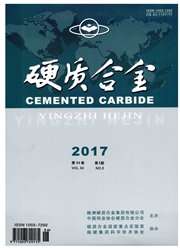

 中文摘要:
中文摘要:
采用扫描电镜,通过对WC原料粉末、脱蜡压坯断口与表面、合金抗弯强度样品断口与合金烧结体表面微观形貌以及合金金相组织的观察,研究了干混合对硬质合金组织结构的影响。结果表明,干混合只对压坯成形过程中粉末颗粒的压制行为与烧结过程中合金的致密化行为产生影响,不会对烧结过程中的合金化行为产生影响。压坯中的大孔洞与未压好等压制缺陷以及显著的元素分布不均匀现象难以通过液相烧结得到有效消除,会继续保留至合金中。采用干混合工艺制备合金,合金晶粒均匀、粗大,接近原料粉末的电镜观测粒度。
 英文摘要:
英文摘要:
The effect of the substitution of dry mixing for wet milling on the microstructure of cemented carbide is studied through the scanning electron microscopy (SEM) observation of tungsten carbide starting material, the skin and the rupture section of dewaxed green compact and as sintered alloy, as well as the polished cross section. It is shown that the substitution of dry mixing for wet milling has an effect on the press behavior of the powder particles and the densitlcation behavior during the sintering process. Nevertheless, the alloying behavior during the sintering process is not affected by the substitution. Defects in the green compact, e.g. big voids and remarkably inhomogeneous element distribution will remain in the alloy. Tungsten carbide grains in the alloy prepared by dry mixing are coarse and homogenous in size, close to the size of tungsten carbide starting material measured by SEM.
 同期刊论文项目
同期刊论文项目
 同项目期刊论文
同项目期刊论文
 Ultrafine and nano scaled tungsten carbide synthesis from colloidal carbon coated nano tungsten prec
Ultrafine and nano scaled tungsten carbide synthesis from colloidal carbon coated nano tungsten prec Directional migration behavior of cerium during the sintering process of mischmetal doped cemented c
Directional migration behavior of cerium during the sintering process of mischmetal doped cemented c Surface adsorption phenomenon during the preparation process of nano WC and ultrafine cemented carbi
Surface adsorption phenomenon during the preparation process of nano WC and ultrafine cemented carbi 期刊信息
期刊信息
